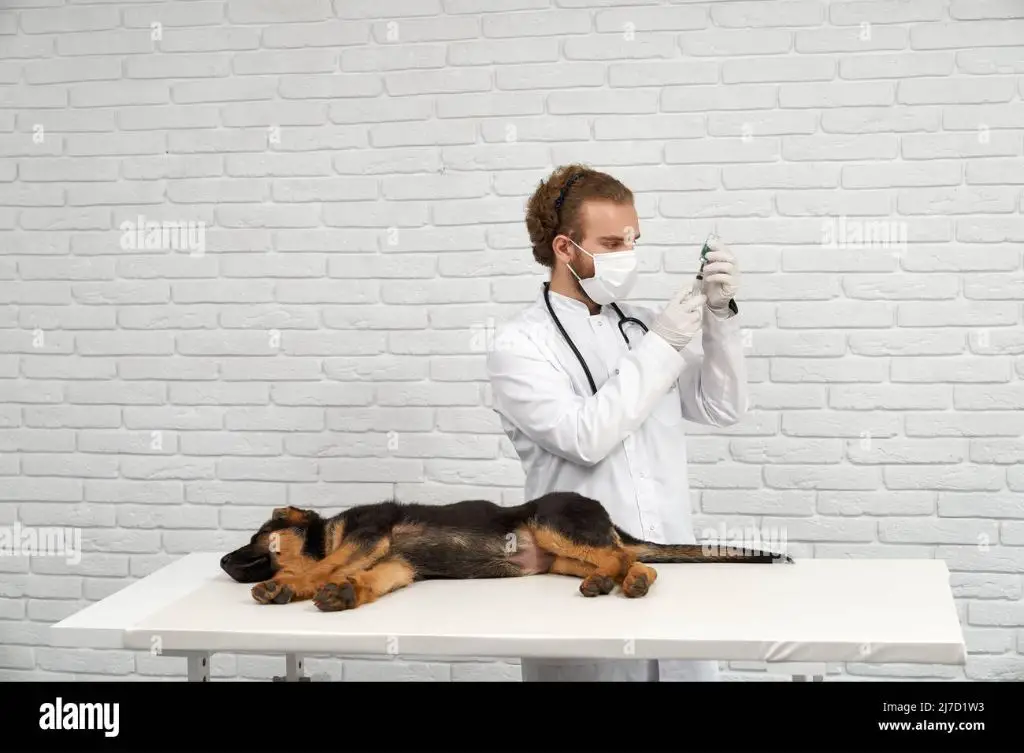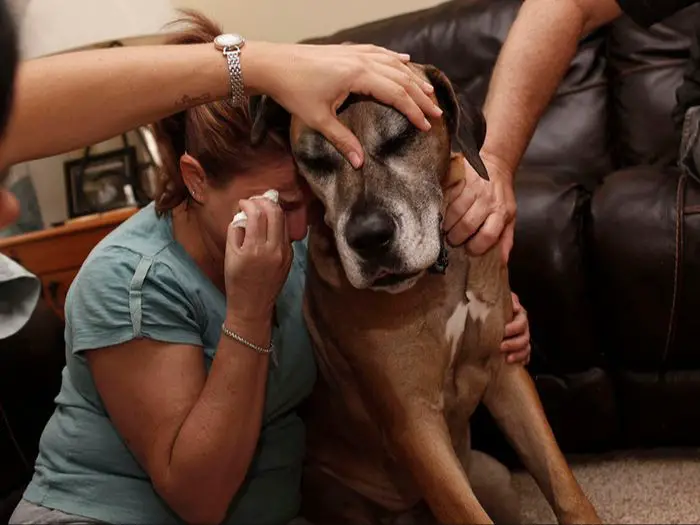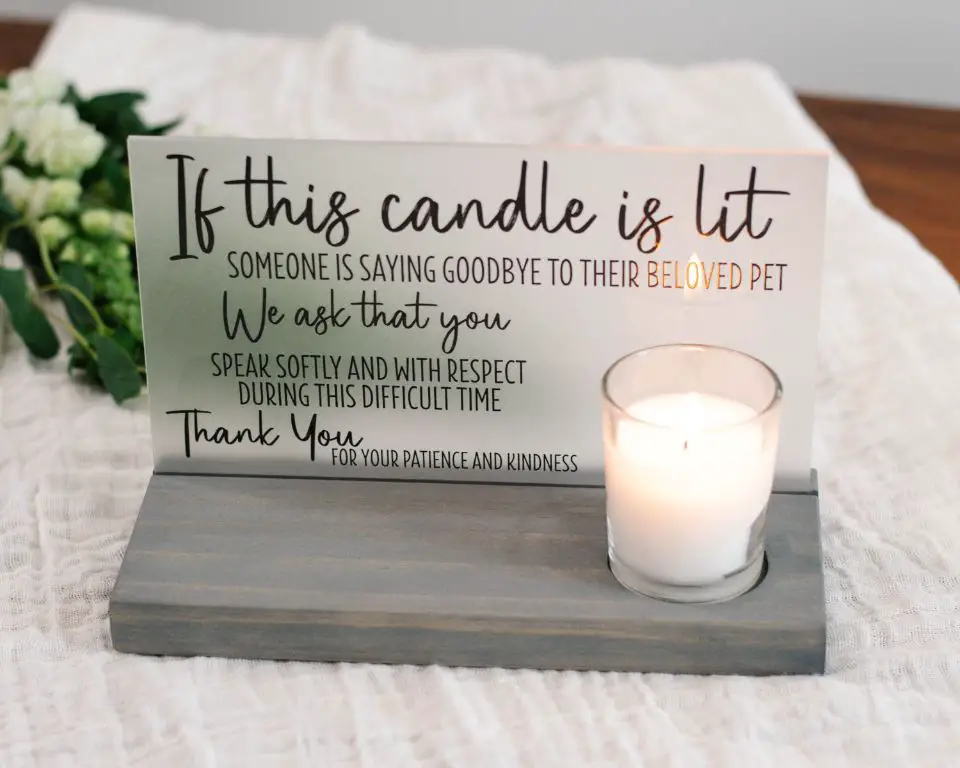The Euthanasia Process
Veterinarians go through several steps to prepare for and carry out the euthanasia process. First, the vet will do a physical exam of the animal to assess its current state of health and determine the appropriate medications and dosages. They will also have an in-depth discussion with the owner to understand the reasons for euthanasia and to ensure the owner gives fully informed consent.

To administer euthanasia, the vet will first give a sedative, often through an intravenous injection, to relax the animal. Once the animal is calmly resting, the vet administers an overdose of an anesthetic drug, usually pentobarbital, also intravenously. This stops the heart and quickly causes death.
After the injections, the vet uses a stethoscope to listen for lack of heartbeat and pulse. They also check the eyes for a fixed, dilated pupil. These signs confirm the pet has passed away. The vet may apply a stethoscope intermittently for 10-15 minutes to reconfirm death before proceeding.
Providing Emotional Support
One of the most difficult parts of the euthanasia process for veterinarians is providing emotional support for grieving pet owners. Many vets allow the family to be present during the procedure so they can comfort their pet and say goodbye. After the pet has passed, vets give the owners time to spend with their deceased pet and create final memories. Some clinics have private rooms where the family can have peace and privacy during this difficult time.

It is important for vets to offer condolences to the grieving family and provide resources to help them through the mourning process. Many clinics give information about pet loss counseling services and grief hotlines. They may also provide memorial options like ink paw prints, locks of fur, or plaster casts as keepsakes. Vets understand the depth of the human-animal bond, and strive to honor that bond by treating the pet and owner with compassion from beginning to end.
Aftercare Tasks
After a pet has been euthanized, there are several aftercare tasks the veterinarian must complete. This includes removing any IV catheters that were placed to administer the euthanasia solution. The vet will gently remove the catheter and clean the area so there is no remaining IV equipment left on the pet’s body.

The veterinarian will then close the pet’s eyes if they are still open. This helps give the pet a more peaceful, resting appearance. It can be emotionally difficult for owners to see their pet with open eyes after passing, so closing the eyelids is an important step.
If the pet’s owner has elected individual or communal cremation, the vet will prepare the body to be transported to the cremation facility. This may involve placing the pet into a basic container or body bag. The vet or a staff member will label the container and log which pet’s body is inside. This ensures proper identification and handling at the cremation facility. The body is then placed in cold storage until the cremation service arrives for pickup.
By thoughtfully attending to these aftercare tasks, the vet provides additional closure for grieving owners and ensures their pet is handled with dignity and care after euthanasia.
Documentation and Administrative Duties
After euthanizing a pet, the veterinarian must complete all documentation and administrative tasks associated with the procedure. This includes entering details about the euthanasia into the patient’s records, providing a death certificate, and settling the billing.
The vet must document information such as the date, time, method of euthanasia, and authorization in the patient file. This creates a formal record of the procedure being performed. The vet may also make notes about the animal’s condition leading up to euthanasia and the owner’s consent.
Veterinarians will provide a death certificate upon request. This serves as legal documentation of the pet’s passing and can assist owners with tasks like notifying pet insurance companies. The certificate states the date and cause of death.
Finally, the veterinary staff will complete any outstanding billing and payment tasks. This may involve preparing itemized invoices, processing credit cards, handling insurance claims, and collecting payment. Settling finances can allow the owners to focus on grieving during this difficult time.
Self-Care for Vets
Performing euthanasia can take an emotional and psychological toll on veterinarians. It’s important for vets to practice self-care to cope with the difficult aspects of the job.

Vets should take breaks between euthanasia appointments whenever possible. Having even a short time to decompress between appointments allows vets to process their emotions and prepare mentally for the next one. It’s best not to schedule back-to-back euthanasia procedures.
Seeking counseling is also very beneficial for vets who perform euthanasia regularly. Having someone objective to talk to about their experiences can help vets work through any issues or trauma associated with the process. Many vet offices now provide counseling services to support their staff.
Relaxation techniques like deep breathing, meditation, yoga, or taking a short walk outside can also help vets relieve stress and center themselves between appointments. Taking just 5-10 minutes for self-care activities can make a big difference in managing the emotional toll.
With the proper boundaries, breaks, and support, vets can gain the resilience needed to provide compassionate end-of-life care as part of their work.
Continuing Bonds After Euthanasia
Losing a beloved pet is incredibly difficult for owners, but it can also be hard on the veterinarians who come to know their patients. To honor the pets they cared for, many vets engage in activities to commemorate the animal and continue the bond:
Sending Sympathy Cards
Veterinarians often send sympathy cards or letters to grieving owners after euthanasia. These notes express condolences and share memories or photos of the pet. This shows the vet’s compassion and validates the owner’s loss.
Making Donations
Vets may make charitable donations or contributions in memory of a pet to an animal welfare organization. This memorializes the pet while also helping other animals in need.
Visiting Pet Memorials
Some veterinary practices create memorial spaces like memory walls or gardens for past patients. Vets may visit these peaceful sites to reflect on pets they cared for.
Vets can also pay respects by visiting a pet’s grave or commemorative markers owners have created. These continue bonds by providing a physical place to remember the animal.
Improving the Process
While veterinarians aim to provide compassionate end-of-life care, there are ways the euthanasia process can be improved. Advocating for at-home euthanasia is one important area. Allowing pets to pass peacefully at home, surrounded by family, can greatly reduce stress and provide comfort. Many states restrict or ban at-home euthanasia, presenting barriers for vets who wish to provide this service. Vets can advocate for regulatory changes to make at-home euthanasia more accessible.
Veterinary schools and clinics can also develop more healing-centered euthanasia protocols. This involves creating a calm, soothing environment with soft lighting, aromatherapy, gentle handling techniques, and mental health support. Some clinics allow families to be present during the euthanasia, permitting goodbyes and final moments together.
Pursuing additional training in veterinary social work is another way vets can improve their ability to handle euthanasia with compassion. Learning specialized counseling skills equips them to guide grieving pet owners through the difficult transition. With training in areas like spirituality, group therapy, and trauma-informed care, vets can better empathize and empower clients.
By advocating for at-home euthanasia, instituting more holistic protocols, and investing in social work skills, vets can transform the euthanasia experience for pets, clients, and themselves.
Why Euthanasia is a Gift
Euthanasia is one of the most difficult aspects of a veterinarian’s job, but it is also one of the most important gifts they can provide. When a pet is suffering and has no quality of life left, euthanasia allows them to pass away peacefully and without pain. It spares them needless physical and emotional distress at the end of life when nothing more can be done medically. Euthanasia is a final act of kindness that veterinarians are honored to provide.
Pet owners often struggle with the decision to euthanize, wanting to avoid it for as long as possible. However, prolonging a pet’s suffering out of our own attachment is unfair to the animal. Euthanasia allows owners to make that painful choice on their own terms, based on their pet’s condition and best interests. It gives them control over orchestrating a peaceful, dignified ending when the time comes.
Though heartbreaking, euthanasia is often the last loving thing we can do for a cherished companion. It alleviates their pain and grants them a graceful exit from life surrounded by caring faces. Witnessing that tranquil passing can bring owners comfort and closure. Euthanasia is never easy, but embracing it as a final gift we give our pets makes it a meaningful farewell.
Coping with Loss
Euthanasia takes a psychological toll on veterinarians. Saying goodbye to an animal is never easy. It is natural to experience grief and sadness when faced with euthanizing a pet. Veterinarians should understand that euthanasia grief is real and profound. It may bring up difficult emotions related to past experiences and losses, feelings of failure or wrongdoing, or moral struggles over the ethics of ending a life.
However, euthanasia is also often an act of love and compassion. Sometimes it is the only way to prevent prolonged suffering and provide a peaceful passing for a pet. Though incredibly hard, letting go can be an act of kindness for animals we have bonded with and cared for. It represents the final caring gift we can provide – relief from pain and a peaceful transition from life to death. Rather than viewing euthanasia as a failure, vets can find meaning in being able to help pets and bring comfort to owners during this difficult process.
To cope with euthanasia grief, veterinarians should acknowledge their feelings and not feel guilty for experiencing loss. It may help to reflect on the positive impact they had on an animal’s life. Taking time to grieve and talk with colleagues who understand can bring comfort. Celebrating an animal’s uniqueness and qualities keeps their spirit alive. Maintaining self-care routines, taking breaks, and pursuing outside interests helps veterinarians process the loss and build emotional resilience when facing euthanasia. Though saying goodbye is never easy, viewing euthanasia as an act of compassion can help veterinarians find meaning in their role guiding pets through the end of life process.
Honoring the Human-Animal Bond
Saying goodbye to a beloved pet is one of the most difficult experiences for many pet owners. Our pets become part of the family, providing unconditional love, comfort and companionship. Although euthanasia can feel like an immensely sad occasion, it’s important to honor the special bond we shared with our furry friends.
Many pet owners find comfort in sharing stories and photos of their pet, reminiscing about all the silly antics, adventures and cherished memories made together. This helps celebrate the joy and purpose their pet brought into their lives. Creating a memorial, planting a tree or holding a small ceremony can also help provide closure while paying tribute to an extraordinary friendship.
Veterinarians often receive touching letters, photos and updates from grateful pet owners even years after their pet has passed. These uplifting stories are a testament to the powerful ways pets touch our hearts and fill our lives with unconditional love. Although saying goodbye is never easy, honoring our pets keeps their spirit alive in our hearts. Their legacy of love lives on through the people and animal lives they impacted.